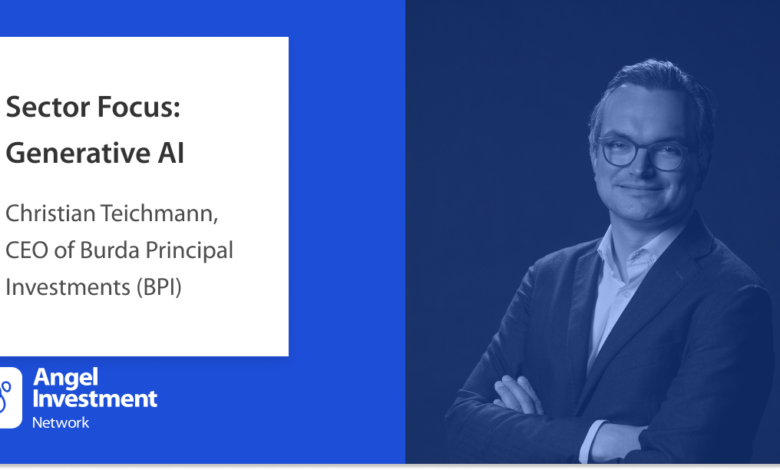Generative AI: The investment opportunity

Generative AI, once a niche topic, has rapidly become a global conversation, even being used in a slanging match between rivals in the US Presidential Election. Its promise is to revolutionise industries and reshape the way we interact with technology.
In our latest Sector Focus article, Christian Teichmann, CEO of Burda Principal Investments (BPI), provides insights into what Generative AI means, the reasons behind its surge in interest, the challenges it faces, and the enticing investor opportunity.
What is generative AI?
AI is a broad term that refers to software or hardware exhibiting behaviours, which appear intelligent, whereas modern AI is mostly focused on a set of techniques called Machine Learning (ML). This enables software programmes to learn through training, instead of being explicitly programmed with rules. Thus far, machine learning was primarily deployed to make predictions.
Generative AI refers to a new wave of ML models – most prominently transformer-based large language models (LLMs) – that are able to create original content in response to natural language prompts. They enable machines to produce text, code, or conduct other creative tasks.
What are the reasons for the rising interest in generative AI?
Another highly exciting feature of these most recent models – besides their ability to not only make predictions but generate original content – is their flexibility driven by scale. While earlier generations of AI systems were mostly good for one specific purpose, newer models can be reassigned from one type of problem to another, closing in on Artificial General Intelligence (AGI). These models are also called “Foundation Models” and promise huge economic potential as general-purpose technologies. We have come to believe that AI will trigger the next wave, i.e. the third wave, of 21st century digital tech innovation, after mobile internet and cloud computing.
What barriers does generative AI need to overcome?
We are at the beginning of the Generative AI journey and foundation models are still in their infancy. The question of what this new platform will look like and who its gatekeepers will be cannot be answered yet.
However, for Generative AI to sustain its promise beyond the initial hype, there are some fundamental challenges to be solved both on the foundation model layer and on the application layer. On the foundation model layer, questions around output explainability, data privacy and copyright concerns need to be answered. On the application layer, startups still need to find innovative ways to derive real and sustainable customer value from the capabilities of generative models. Another challenge for startups is the importance of data and the capital, when it comes to building defendable products in this space; here, large incumbent companies typically have an advantage over young companies.
What is the investor opportunity?
So far, most VC-backed companies within the Gen AI landscape are either active at the core infrastructure layer or providing horizontal applications across industries. Most funding allocated on the application layer is being invested in horizontal use cases that address various industries with function-specific generative capabilities (e.g. customer support or sales communication). In some of the more obvious segments we already identify a very high number of early-stage startups (e.g. up to 140 for text generation for marketing purposes).
For the future, we expect more Generative AI applications to emerge for domain-specific use cases as the core infrastructure platform matures. The reasons for this assumption are the following: Tackling of industry-specific challenges and access to unique proprietary data.
Vertical-specific products will be better equipped to leverage domain-specific datasets to create or finetune more precise and defendable models. Additionally, companies focused on specific verticals or domains may be more able to come up with novel and unique user interfaces between customers and models to solve industry-specific challenges. These user-interfaces don’t need to be as flexible as those for horizontal use cases that serve multiple industries, further raising barriers of entry. However, the addressable market size of vertical applications is likely to be scrutinised, due to their narrower focus.
Which companies are doing interesting things in this space?
On the foundation model layer, Aleph Alpha has built some unique capabilities (e.g. explainability) into their large language model Luminous, which is the only European large language model operating at scale. On the application layer, we see more and more interesting cases of vertical use cases emerging. For example, Harvey or Casetext in the Legal Vertical or Genei and Scispace in the Education Vertical.
Tell us about your forthcoming DLD AI Summit?
DLD (Digital, Life, Design) is the international conference and innovation platform of Hubert Burda Media and BPI is a long-term partner of DLD. On September 7th, the first ever DLD AI Summit is taking place in Munich and BPI is co-hosting the conference alongside other partners. The DLD AI Summit will address AI´s technological evolution and its impact on all areas of life. The topic will be discussed on an interdisciplinary level, and we are looking forward to high-level speakers on the panel, such as Jonas Andrulis, Founder and CEO of Aleph Alpha, Dex Hunter-Torricke, Head of Global Communications and Marketing at DeepMind, Mark Surman, President of the Mozilla Foundation and Thomas Saueressig, Member of the Executive Board of SAP.
About BPI
BPI provides long term growth equity for fast growing digital technology companies, primarily investing in platforms & marketplaces, fintech, B2B SaaS, digital networks, cybersecurity, AI, food tech and commerce-enabling tech.
There will be a livestream of the DLD AI Summit: https://dld-conference.com/
Join the world’s largest angel investment network, where global angel investors meet the great businesses of tomorrow.





